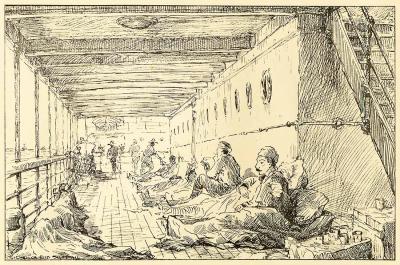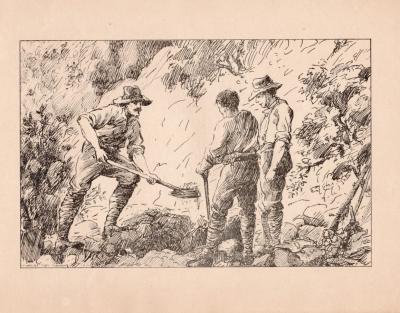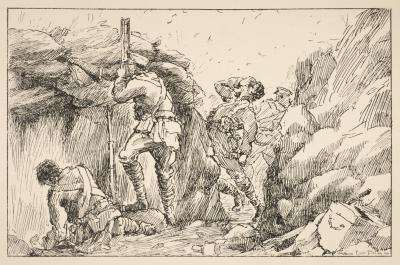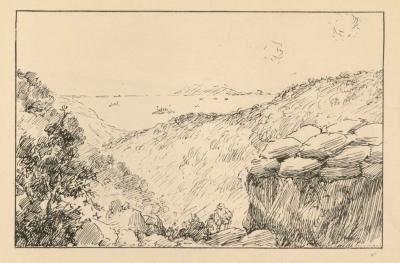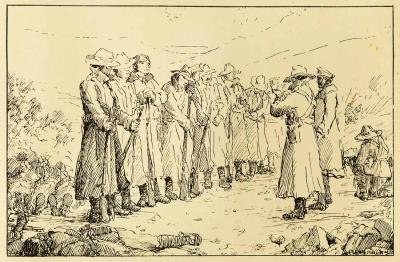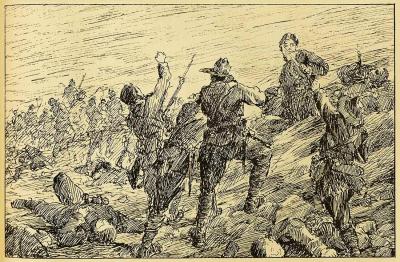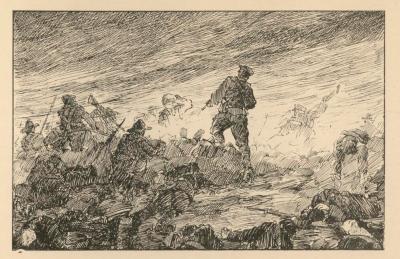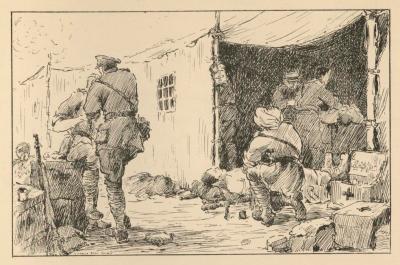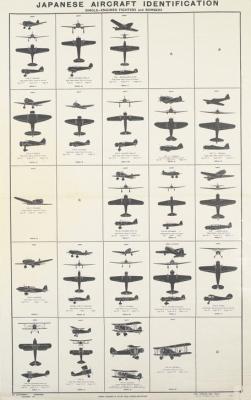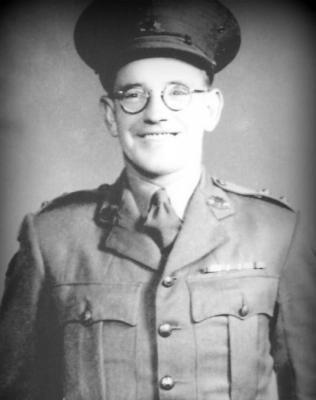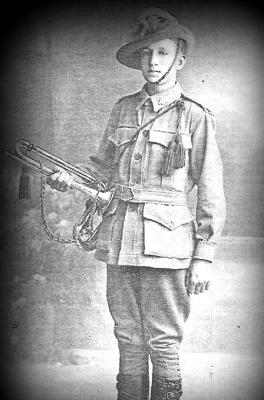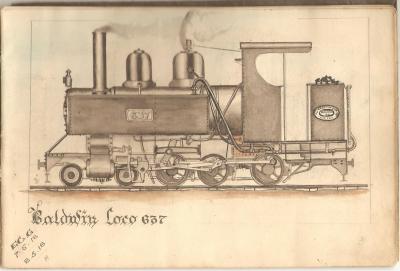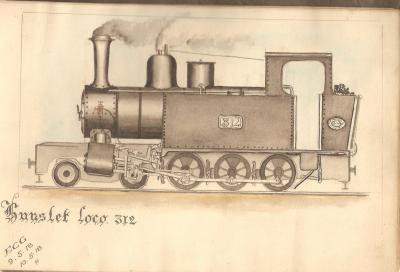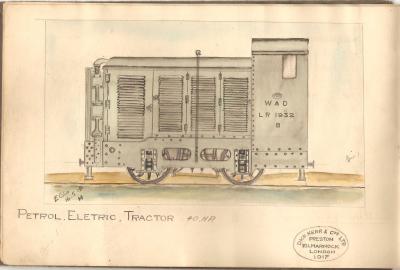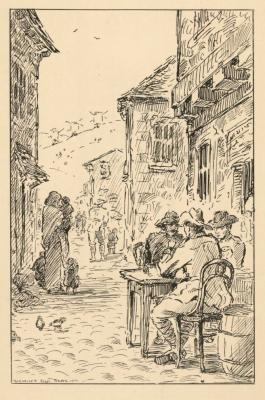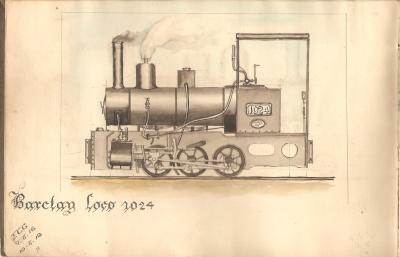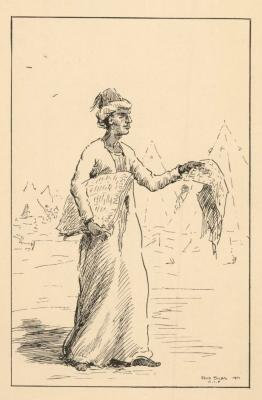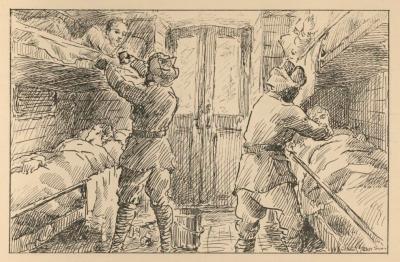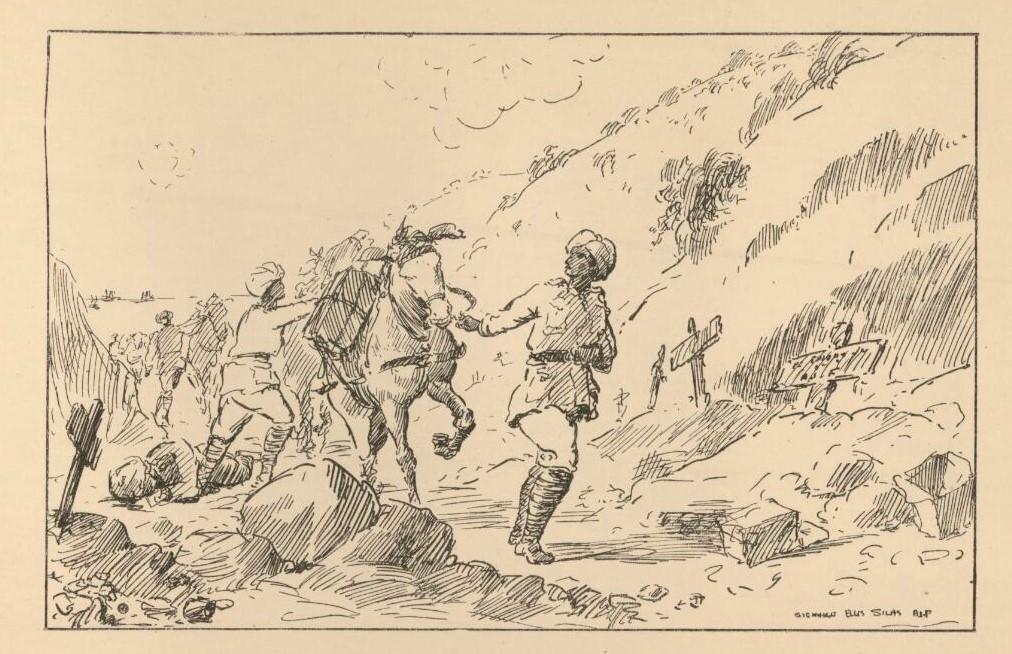World War 1, South-West Asia, Turkiye, Gallipoli, Anzac Cove, SILAS, "Crusading at Anzac"
Extract from "Crusading at Anzac", "Near the Beach". Sketch by Ellis Silas
Ellis Luciano Silas (13 July 1885 - 2 May 1972) was a British artist and draughtsman who served as an ANZAC during World War 1. He was .born in London, Silas' grandfather was the Anglo-Dutch composer Edouard Silas and his father, Louis Silas was an artist. Silas studied art from his father and was also a student of the artist Walter Sickert. In 1907, aged 23, Silas moved to Australia where he continued to develop as a painter.He painted in Sydney and Melbourne before settling in Perth.
Silas enlisted in the Australian Imperial Force (AIF) in October 1914.. Silas was never confident that he would make a good soldier even though he had served in the Royal Naval Volunteer Reserve and had some experience of military life. Silas embarked with the 16th Infantry Battalion for Egypt in December 1914. Throughout early 1915, Silas continued his training as a signaller outside Cairo, Egypt.
On the evening of 25 April 1915, the battalion was waiting on the deck of a transport to go ashore on Gallipoli The Battle of the Landing on Gallipoli in which the 16th Battalion took part lasted from 25 April to 3 May 1915. Silas told some of the battalion's story after the Gallipoli Campaign in a book called Crusading at Anzac AD 1915. Silas' book is based on extracts from the diary and sketchbook he kept during his time at Anzac. His words and images provide a dramatic insight into the dangers, hardships and loss that accompanied the Anzacs as they tried to establish a foothold on the Gallipoli peninsula.
Silas landed on Gallipoli in the evening of 25 April with the 16th Battalion. In the first weeks on Gallipoli, 16 Battalion was reduced to two companies suffering heavy casualties at Pope’s Hill and Quinn’s Post. By 17 May, Silas had become seriously ill and was taken by hospital ship back to Egypt. From Egypt, he was transferred to England and in August 1916, was discharged from the AIF as being permanently unfit for active service.
His sketches from the front were viewed by King George and Queen Mary in May 1916. His book Crusading at Anzac was published in 1916 with forewords by Sir Ian Hamilton and William Birdwood.
Details
Details
Near the Beach.
AFTER the incessant roar of the firing line, it seemed comparatively quiet at this spot. It was the end of a glorious afternoon. All the landscape was tinged with the warm glow of the sun. In the distance the blue ocean sparkled like a jewel. Up the narrow winding path, with its borders of sad little mounds, came the Indians with the ammunition mules, It seemed more like a scene in a play than one of the most tragic dramas in the world’s history. But one was never left long in doubt as to the reality of it all. A buzzing – as of a huge bee – a flash of yellow flame – on the ground, a mangled heap, from which trickles a dull red stream. Far away across the sapphire ocean, just a few more will be waiting in vain for the return of their loved ones.
Anzac, May, 1915.
Signaler Ellis Silas was the only artist to paint and sketch actual battle scenes showing Australian soldiers in action at Gallipoli. He was commissioned in 1919 by the Australian War Records Section to paint images of Gallipoli at the initiative of C. E. W. Bean who wanted ex-servicemen to paint from their experiences. An exhibit featuring the life and art of Ellis Silas including "Crusading at Anzac" is currently on display in the Temporary Exhibition Gallery at the Army Museum of Western Australia.
Open in Google Maps
Nearest geotagged records:
- World War 1 , Europe Türkiye Gallipoli, Anzac Cove, 1915 (0.03km away)
- World War 1, Europe Türkiye, Gallipoli, Anzac Cove, 11 Battalion, 1915 (0.05km away)
- World War 1, Australia, Western Australia, 791 De MOLE, 10 Light Horse (0.05km away)
- World War 1, Australia, Western Australia, 372 BLAKE, 10 Light Horse (0.05km away)
- World War 1, Australia, Western Australia, 148 GRAY, 10 Light Horse (0.05km away)
- World War 1, Australia, Western Australia, 878 LEWIS, 10 Light Horse (0.05km away)
- World War 1, 33 LAILEY, 10 Light Horse (0.05km away)
- World War 1, Europe Türkiye, Gallipoli, Anzac Cove, Shrapnel Valley, 1915 (0.07km away)
- World War 1, Europe Türkiye Gallipoli, 1915 (0.29km away)
- World War 1, South-West Asia, Turkiye, Gallipoli, Anzac Cove, SILAS, "Crusading at Anzac" (0.37km away)
Australian Army Museum of Western Australia
Australian Army Museum of Western Australia
More items like this
- World War 1, South-West Asia, Turkiye, Gallipoli, Anzac Cove, SILAS, "Crusading at Anzac"
- World War 1, South-West Asia, Turkiye, Gallipoli, Anzac Cove, SILAS, "Crusading at Anzac"
- World War 1, Europe, Türkiye, Gallipoli, Anzac Cove, SILAS, "Crusading at Anzac"
- World War 1, South-West Asia, Turkiye, Gallipoli, Anzac Cove, SILAS, "Crusading at Anzac"
- World War 1, South-West Asia, Turkiye, Gallipoli, Anzac Cove, SILAS, "Crusading at Anzac"
- World War 1, South-West Asia, Turkiye, Gallipoli, Anzac Cove, SILAS, "Crusading at Anzac"
- World War 1, South-West Asia, Turkiye, Gallipoli, Anzac Cove, SILAS, "Crusading at Anzac"
- World War 1, South-West Asia, Turkiye, Gallipoli, Anzac Cove, SILAS, "Crusading at Anzac"
Other items from Australian Army Museum of Western Australia
- Poster - Japanese Aircraft Identification
- World War 1, Australia, Western Australia, 265 EAVES, 10 Light Horse
- World War 1, Australia, Western Australia, 266 EDWARDS, 10 Light Horse
- Railway Operating Division - World War 1, Technical Drawing, GARBETT, 1917
- Railway Operating Division - World War 1, Technical Drawing, GARBETT, 1918
- Railway Operating Division - World War 1, Technical Drawing, GARBETT, 1918
- Railway Operating Division - World War 1, Technical Drawing, GARBETT, 1918
- Railway Operating Division - World War 1, Technical Drawing, GARBETT, 1918
- World War 1, South-West Asia, Turkiye, Gallipoli, Anzac Cove, SILAS, "Crusading at Anzac"
- Railway Operating Division - World War 1, Technical Drawing, GARBETT, 1918
- World War 1, South-West Asia, Turkiye, Gallipoli, Anzac Cove, SILAS, "Crusading at Anzac"
- World War 1, South-West Asia, Turkiye, Gallipoli, Anzac Cove, SILAS, "Crusading at Anzac"
